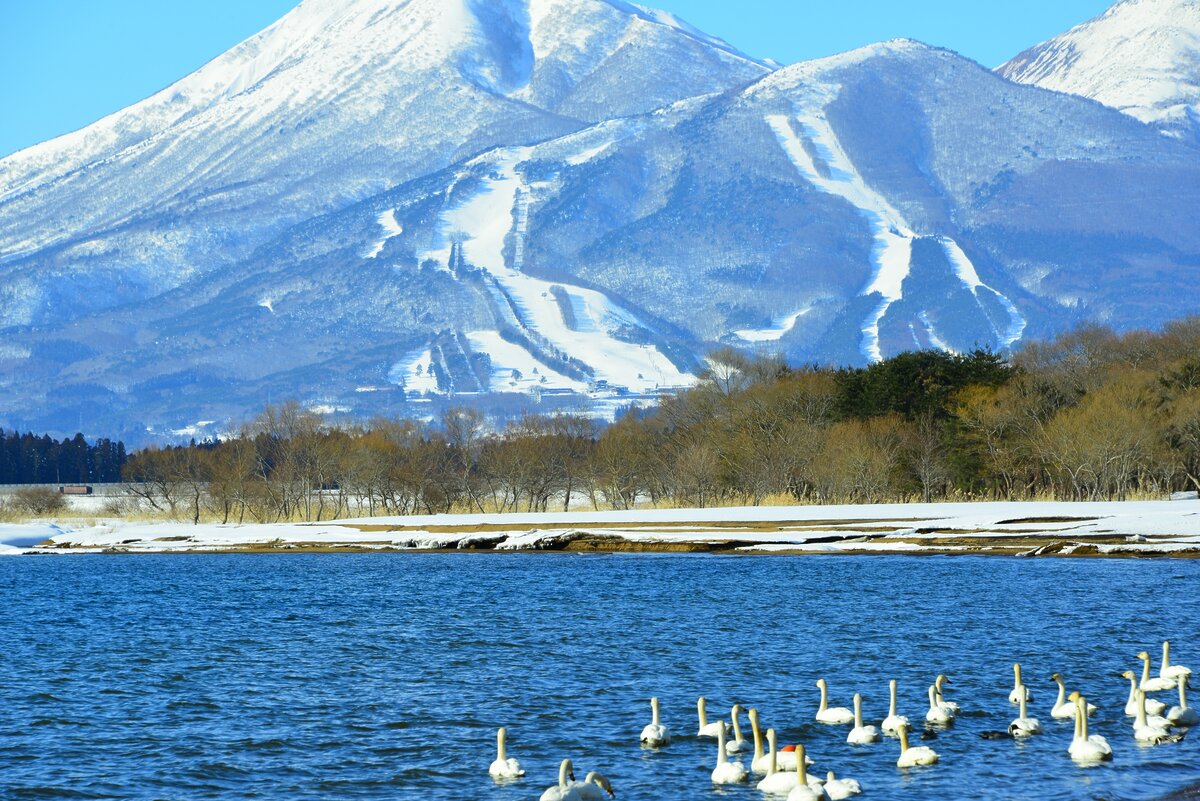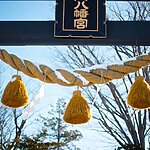
Introducing popular temples and shrines recommended for the first visit to the New Year of the Year of the Snake (Fukushima Prefecture)!
table of contents
Fukushima Prefecture has long been the gateway to Michinoku, bringing western culture with it, and while there are many historic shrines and temples dating back to the Kofun period, there are also shrines and temples with a shorter history that enshrine special deities
In this article, we will introduce three shrines, both old and new, that are recognized as particularly powerful power spots and are said to bring many blessings
Isasumi Shrine (Aizumisato Town)

Isasumi Shrine , known as " Iwashiro Province's First Shrine and the main shrine of Aizu , the Kojiki, is said to be the shrine where the place name "Aizu" originated.
The origin of the name is said to be that among the "Four Generals" dispatched by the 10th Emperor Sujin to conquer the regions, Ohiko no Mikoto of the Hokuriku Road and Takenumakawawake no Mikoto of the Tokaido Road met here and enshrined Izanagi no Mikoto and Izanami no Mikoto as deities protecting the nation

In Aizu, it is considered a prestigious and powerful power spot that has been deeply protected by successive feudal lords, including the Ashina family and Aizu domain founder Hoshina Masayuki, and is visited by worshippers from all over the country
The deity and blessings of Izasumi Shrine

The four deities enshrined here are Izanagi-no-Mikoto, Izanami-no-Mikoto, Ohiko-no-Mikoto, and Takenunakawawake-no-Mikoto
The four enshrined deities are also called "Isasumi-no-Okami" or "Isasumi Daimyojin."
Izanagi and Izanami, who are said to be two of the "Seven Generations of Gods" (Kamiyonanayo), gods who created the heavens and the earth in Japanese mythology, churned the sea to create the land of Japan (Kuniumi) and gave birth to all the gods of the universe (Kamiumi)

The two deities enshrined here, Ohiko no Mikoto and Takenumakawawake no Mikoto, are also enshrined here, and it is said that the shrine bestows a wide range of benefits, including marital harmony, matchmaking, business development, bountiful harvests, protection from evil spirits, and protection from misfortune
Furthermore, Izasumi Shrine offers the "Good Luck Charm," which is said to be the most powerful of all talismans and is valid for two years, and is a popular item that is said to greatly increase your luck
Information on New Year's visits to Isasumi Shrine
The schedule of festivals and events for the New Year period is as follows: on December 31st, from 4:00 pm, the New Year's purification ceremony (garden festival, main shrine festival) will be held, followed by the closing of the gates at 6:00 pm and the New Year's Eve festival from 11:00 pm. The gates will reopen at midnight on New Year's Day and will be open to worshippers 24 hours a day
On New Year's Day, the New Year's Festival is held from 9:00 a.m., and the amulet and talisman distribution center is open from midnight to 6:00 p.m., but from the 2nd onwards it is open from 8:00 a.m. to 6:00 p.m
Please note that during the extremely busy period from December 31st to January 5th, five temporary parking lots will be set up around the shrine for first shrine visits of the year. Please make use of these parking lots
Isasumi Shrine <Information>
- Facility name: Isasumi Shrine
- Address: 4377 Miyabayashi-ko, Aizumisato-machi, Onuma-gun, Fukushima Prefecture
- Phone number: 0242-54-5050
- Prayer reception hours: 9:00-15:00
- Gift reception hours: 9:00-16:00
- URL: Isasumi Shrine official website
GOOGLE MAP
Kaiseiyama Daijingu Shrine (Koriyama City)

Located next to Kaiseiyama Park, a famous cherry blossom viewing spot in downtown Koriyama City, this is the only shrine in Japan that is dedicated to a branch of the Ise Grand Shrine, and is one of the most powerful spots in the Tohoku region, earning it the nickname "Oisesama of the Tohoku Region."
In January 1876 (Meiji 9), permission was granted to enshrine a branch of the Ise Shrine, and the shrine was named Kaiseiyama Daijingu. By October 1874, the main hall and worship hall had been completed using lumber that had been used at the Ise Shrine
It is said that permission to split off the deity was granted by Emperor Meiji, who was concerned about the situation of the various domains in Fukushima Prefecture, such as Aizu and Nihonmatsu, which had been branded as enemies of the Imperial Court during the Boshin War
Although the shrine has a short history since its founding, it was deeply revered as a spiritual anchor for the pioneers involved in the Asaka reclamation in the Meiji era, and even today it attracts many worshippers from all over the country for events such as the first visit of the year
Kaiseiyama Daijingu Shrine's Deity and Benefits

The three deities enshrined here are Amaterasu Omikami, Toyoukehime, and Kamuyamatoiwarehiko-no-mikoto (the first Emperor Jimmu)
The blessings that are said to be bestowed upon the shrine include "good fortune," "fulfillment of wishes," "bountiful harvests," as well as "easy childbirth and child-rearing," "matchmaking," "academic success," "protection from misfortune," "prosperity in business," "traffic safety," and "good health and safety."
Within the grounds is Kaiseiyama Inari Shrine, a subsidiary shrine, which enshrines Ukanomitama-no-kami, also known as Toyouke-no-Okami, and is said to bring blessings such as "prosperous business" and "development of various industries."
Kaiseiyama Daijingu Shrine New Year's visit information
During the New Year's visit period, the parking lot on the temple grounds will be very crowded, so temporary parking will be set up at the following locations
- West parking lot of "Koriyama Women's University Kindergarten" side: December 31st, 10:00 PM to January 4th, 5:00 PM
- West parking lot of Koriyama City Kaiseiyama Park: January 1st to January 5th
If you are visiting by car, please note that part of the road north of the shrine will be closed from 10:00 PM on December 31st to 3:00 AM on January 1st
New Year's events include the Saitansai Festival on New Year's Day, which starts at midnight, and the Sagicho Festival on the 7th, which starts at 7am and ends at 3pm
In addition, the distribution times for gifts during the New Year will be as follows:
- New Year's Day (Wednesday): Twice, from midnight to 3am and from 6am to 10pm
- 2nd (Thurs) and 3rd (Fri): 8:00 to 21:00
- 4th (Sat) and 5th (Sun): 8:30am to 6pm
- 6th (Fri): 8:30am to 9pm
- 7th: 7:00am - 5:00pm
From Sunday the 8th onwards, the reception hours for prayers and offerings will be from 9:00 to 16:30

Additionally, stalls will be set up within the shrine grounds from 1:00 PM on New Year's Eve until January 7th, so please check the shrine's official website for opening times and other information
Kaiseiyama Daijingu Shrine <Information>
- Facility name: Kaiseiyama Daijingu Shrine
- Address: 3-1-38 Kaisei, Koriyama City, Fukushima Prefecture
- Phone number: 024-932-1521
- Prayer reception hours: 9:00-16:30
- Reception hours for awarded items: 9:00-16:30
- URL: Kaiseiyama Daijingu Shrine official website
GOOGLE MAP
Tsutsukowake Shrine (Tanagura Town)

There are two Tsutsukowake Shrines in Tanagura Town Tsutsukowake Shrine (Baba Tsutsukowake Shrine) in Baba, Tanagura Town, and Tsutsukowake Shrine (Yatsuki Tsutsukowake Shrine) in Yatsuki, Tanagura Town.

Both shrines are said to have been founded when Yamato Takeru no Mikoto, the son of the 12th Emperor Keikō, erected a spear on Mount Tsutsuko (Mount Takehoko in Shirakawa City, Fukushima Prefecture) and enshrined Ajisuwa Takahikone no Mikoto during his expedition to Oshu

Tsutsukowake Shrine is considered to be the "Ichinomiya of Mutsu Province," but it is still not clear which is the historical main shrine, and both shrines are treated as main shrines in the Engishiki Shinmeicho

three Chikatsu shrines, Chikatsu Shrine in Daigo, Ibaraki Prefecture is the Shimomiya (Lower Shrine), Baba Shrine is the Kamimiya (Upper Shrine), and Yatsuki Shrine is the Nakamiya (Middle Shrine) , but the truth is unknown.
The deity and blessings of Tsutsukowake Shrine

The main deity is Ajisuki Takahikone no Mikoto, who is said to have been enshrined by Emperor Yamato Takeru, and it is said that Emperor Yamato Takeru was enshrined as a co-deity in 807 (Daido 2)
Ajisuki Takahikone no Mikoto is the god of agriculture and thunder, and is said to grant blessings such as bountiful harvests, protection of real estate, prosperity in business, safety of the home, and matchmaking. As he also has the divinity of a snake god, he is recommended as a first shrine visit for the Year of the Snake in 2025
It is also a power spot for Yamato Takeru, a legendary hero who conquered the Kumaso and the eastern provinces, and is known in novels, movies, manga, and anime, and is said to bring good fortune in overcoming difficult situations and granting lasting military fortune
Information on New Year's visits to Tsutsukowake Shrine

For the first visit of the year, the "three shrine pilgrimage," which involves visiting the three Chikazu shrines in one day, is popular as it is believed to bring greater blessings
There is parking for about 20 cars at Yatsuki Shrine, but there is none at Baba Shrine, so you will have to use the parking lot north of the nearby Tanagura Town Hall

The time for receiving the gifts at Yatsuki Shrine is between 9:30 and 16:00, but there is no information on the time at Baba Shrine, perhaps because the chief priest's home is the shrine office
We recommend calling to confirm before visiting
Yatsukitsutsukowake Shrine <Information>
- Facility name: Yatsukitsutsukowake Shrine
- Address: 224 Yatsuki Omiya, Tanagura-cho, Higashishirakawa-gun, Fukushima Prefecture
- Phone number: 0247-33-3505
- Prayer reception hours: 9:30-16:00
- Gift reception hours: 9:30-16:00
- URL: Tanagura Town Tourism Association Official Website
GOOGLE MAP
Baba Totokowake Shrine (Baba Totokowake Shrine) <Information>
- Facility name: Baba Totokowake Shrine (Baba Totokowake Shrine)
- Address: 39 Tanagura Baba, Tanagura-cho, Higashishirakawa-gun, Fukushima Prefecture
- Phone number: 0247-33-7219
- Prayer reception hours: Unknown
- Award acceptance time: Unknown
- URL: Tanagura Town Tourism Association Official Website
GOOGLE MAP
summary
In this article, we have introduced three shrines that are recommended for hatsumode (first visit of the year), but it is also nice to visit a temple on New Year's Eve while listening to the sound of the bells ringing
For your first visit to a temple, we recommend one that enshrines Samantabhadra Bodhisattva, the guardian deity of the Year of the Snake, the zodiac sign for 2025, as it is said that you can expect to receive good fortune
Why not look up the principal image of a deity at a nearby temple and visit it?










![Introducing popular temples and shrines recommended for the first visit to the New Year of the Year of the Snake [Iwate Prefecture]! Iwate Catch](https://jp.neft.asia/wp-content/uploads/2024/12/077d99f4a92a0a35be153e3c80aefe9a-150x150.jpg)


![A report on the experience of "Whiskey Collection Koriyama," Tohoku's first whiskey event! [Fukushima Prefecture] Whiskey Collection Koriyama](https://jp.neft.asia/wp-content/uploads/2024/10/IMG_0751-EDIT-150x150.jpg)
![The delicacy "Anko" is a delicious winter taste on the beach! [Fukushima Prefecture] Monkfish](https://jp.neft.asia/wp-content/uploads/2022/02/2054097_m-150x150.jpg)
![A tour of the 33 remaining Kannon in Minami Aizu. "Thirty-three Kannon" certified as a Japanese Heritage Site [Fukushima Prefecture] 11_MG_9631](https://jp.neft.asia/wp-content/uploads/2022/11/11_MG_9631-150x150.jpg)











